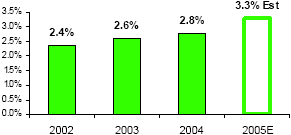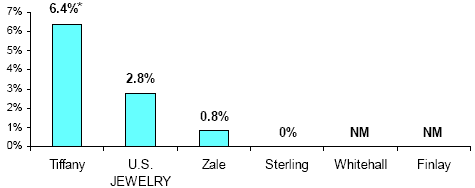IDEX Online Research: Online Commerce At Sterling Jewelers: Not “If”, But “When”
October 06, 05
Sterling Jewelers remains the last holdout among the major U.S. jewelry chains to enter the internet commerce fray. However, its parent company, Signet Group, recently announced that its U.K. mass market division, H. Samuel, would begin selling jewelry online. In response to a query about the possibility of U.S.-based Sterling Jewelers selling jewelry online, Signet Group Chairman Terry Burman replied that “it is not a matter of ‘if’, rather, it is a matter of ‘when’”.
A little background will help put things into perspective. Jewelers were initially slow to embrace the internet as a new channel of distribution. It might work for commodity items such as books and music, they reasoned, but it won’t work for luxury items like jewelry which appeal to the emotions.
By the late 1990s and early 2000s, jewelers began to see the potential of online commerce. While the world must have pioneers to explore new horizons, those pioneers often have a short lifespan. Such was the case with the jewelry industry.
The retail road is littered with the corpses of failed online jewelry merchants. Names like miadora.com, gemconnect.com, enjewel.com, valueamerica.com and others are defunct. Only Blue Nile, which started its operations in 1999, has been a clear winner.
By the early 2000s, most of the major store-based U.S. jewelry chains had an internet presence. These efforts were touted to Wall Street, which had become enamored with online commerce. The tech bubble may have burst in 2001, but that didn’t stop major chain jewelers from moving ahead with online sales efforts.
In the U.S., research shows that about 3% of all jewelry (by value) is sold online; most of this business is done by online merchants such as Blue Nile, Odimo, and others. Conversely, however, that means 97% of all jewelry is still sold by store-based merchants.
| U.S. Online Jewelry Sales |
Efforts to sell jewelry online by existing store-based jewelers have met with marginal success. Tiffany & Co., the world renowned jeweler, offers a selection of 2,800 items for sale online. Tiffany’s revenues from combined online and catalog sales were about $141 million in 2004 or just over 6% of sales (the company does not provide a breakout of online sales only). Zale Direct (all non-store revenues including the internet) posted sales of $18 million for the twelve months ended July 2005; this was less than 1% of total Zale Corporation revenues. Neither of these companies or any other chain jewelers are touting their internet efforts. We think there is good reason: growth has been below plan and profits are elusive.
| Internet Sals as Percentage of Total Revenues Source: Company reports |
Sterling Jewelers, along with all of Signet Group divisions (H. Samuel and Ernest Jones), has remained the lone online commerce holdout among the majors until now. While all of Signet’s major jewelry brands have websites, they haven’t been selling jewelry online.
Why did Signet choose H. Samuel for its first online commerce effort? The company cited several reasons: 1) H. Samuel already had a good website; and, 2) Signet research showed that H. Samuel customers often look on the web before going into the store to make a jewelry purchase. Not surprisingly, the Ernest Jones customer – a higher-end U.K. consumer – checks the web less frequently before shopping for jewelry. Older, wealthier consumers who shop at Ernest Jones stores simply haven’t embraced the web nearly as much as younger, mass-market consumers who shop at H. Samuel stores.
It is significant to note how H. Samuel, with just under 400 stores in the U.K., has finally initiated its online commerce effort:
- Leading edge search and navigation system – The company waited until technology systems had been perfected to develop one which should work immediately, rather than struggling to create technology and an online presence simultaneously.
- 2,200 items – Among the items offered are a selection of diamond and other gem-set jewelry, gold and silver jewelry, watches, and gifts. In other words, the online site is reflective of the H. Samuel stores’ selection. But, at 2,200 items, it is only a sampling of the company’s product line. Why? We’ll bet that these items were carefully chosen. While we have not analyzed the merchandise, it’s safe to say that most of the merchandise will be sharply priced and not readily comparable to offerings from online discounters.
- Pricing is the same for online shopping as for in-store purchases – This is a bold move. Other than Tiffany, many other jewelers try to compete on price with Blue Nile and other discounters (most pure online jewelry merchants operate with a gross margin which is about half the level of a store-based retailer). Most store-based retailers don’t have the corporate culture to implement the kind of low-cost infrastructure that can support high volumes at low margins.
- Returns policies are the same for online shoppers as for store shoppers – Want to return something? If you bought it online, you can return it in the store. If you bought it in the store, return it via post. Your refund will be immediate.
- Customer telephone support is provided by a special team in the existing call center facility – This is more important than it sounds. The online customer support people are specially trained to serve shoppers who opt to buy via this new sales channel. But the distribution system – picking, packing, posting -- is supported by an existing proven infrastructure.
- Fraud avoidance procedures are state-of-the-art – H. Samuel has the latest anti-fraud systems. They won’t be taking orders from that “special” customer in Nigeria who has managed to defraud almost every other online jeweler over the past few years.
- Every H. Samuel store manager is on board – Every one of the 391 H. Samuel store managers has been trained on how to interface with this new sales channel. In contrast, most other chain jewelers have left their store managers out of the process, citing that “the internet is a different business.”
When will e-commerce come to Sterling Jewelers and its three brands – Kay, Jared, and the regionals which operate under a variety of names? According to Burman, it is not a matter of “if”; rather, it is a matter of “when.” And, he added, it “won’t be too long.”
What will be Sterling’s criteria for initiating e-commerce?
- Research – In keeping with its culture, Sterling analyzes and reanalyzes and then again analyzes its challenges. Its research efforts are monumental. Research is playing a major role in the creation of its online commerce efforts.
- Market share – Sterling will utilize e-commerce only if it thinks it can increase its market share. This means that the company must do more than transfer sales from one sales channel (the store) to another (the internet). It must capture sales online that it would have otherwise lost to competitors.
- Margins & costs – The economic model for e-commerce is vastly different from typical store economics. Sterling says it must understand the e-commerce economic model before it jumps into e-commerce.
- Profits – Sterling expects its online commerce division to be profitable within a reasonable period of time. Until management is satisfied that profits are forthcoming, don’t look for online commerce from Sterling.
- Other benefits – Besides commerce, Sterling understands that there are other benefits from online commerce, including marketing and customer service benefits. The company already has a website; marketing and customer service are already part of the current website. But online commerce demands new marketing and customer service initiatives, which Sterling will have in place before selling the first piece of jewelry.
All of these points sound very logical. Any good business person would be expected to evaluate an online commerce effort against these points. But the problem is that too many management teams, in their rush to market, apparently overlooked the basics of the jewelry business. In the paraphrased words of Signet’s chairman Terry Burman, competitors have the write-offs, scars, and losses to prove they went first. When Sterling goes, it will go correctly, in our opinion.

